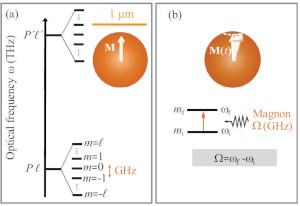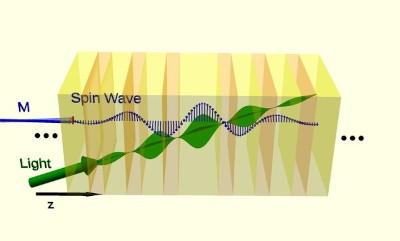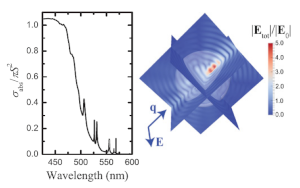Light in time varying media, interaction of waves, Optomagnonics, Acoustooptics
Optomagnonics, magneto-photonic structures
Controlling the interaction of visible and infrared light with magnetization waves at the nanoscale provides impressive opportunities for developing novel efficient miniaturized devices for magnetic recording and information processing applications. In particular, there is recently growing research interest on bidirectional conversion between microwave and optical photons mediated by macroscopic collective spin excitation modes in (sub)millimeter magnetic dielectric spheres, which opens a promising route for transducing quantum information between superconducting qubits and photons.


Finite-element simulations, in parallel with multiple scattering calculations, are employed for studying the magneto-optical response of complex nanopaterned structures or surfaces. The Faraday and Kerr effects can be appropriately tailored or optimized, depending on the respective application.

References:
Metal-nanoparticle arrays on a magnetic garnet film for tunable plasmon-enhanced Faraday rotation, E. Almpanis, P. A. Pantazopoulos, N. Papanikolaou, V. Yannopapas, and N. Stefanou, Journal of the Optical Society of America B 33 (12), 2609-2616 (2016). https://doi.org/10.1364/JOSAB.33.002609
A birefringent etalon enhances the Faraday rotation of thin magneto-optical films, E. Almpanis, P. A. Pantazopoulos, N. Papanikolaou, V. Yannopapas, and N. Stefanou, Journal of Optics, 19, 075102 (2017). https://doi.org/10.1088/2040-8986/aa7420Controlling the transverse magneto-optical Kerr effect with near-zero refractive index bi-gyrotropic metamaterials, E. Almpanis, M. Amanollahi, and M. Zamani, Optical Materials, 99, 109539 (2020). https://doi.org/10.1016/j.optmat.2019.109539
Controlling the spontaneous light emission with elastic waves
The modulation of spontaneous light emission of active centers through elastic waves in Si ∕ SiO2 multilayer phoxonic structures that support dual photonic-phononic localized modes, in the bulk or at the surface, is studied by means of rigorous full electrodynamic and elastodynamic calculations. Our results show that strong dynamic modulation of the spontaneous emission can be achieved through an enhanced acousto-optic interaction when light and elastic energy are simultaneously localized in the same region.


Tuning the spontaneous light emission in phoxonic cavities, E. Almpanis, N. Papanikolaou, G. Gantzounis, and N. Stefanou, Journal of the Optical Society of America B 29(9), 2567-2574 (2012). http://dx.doi.org/10.1364/JOSAB.29.002567